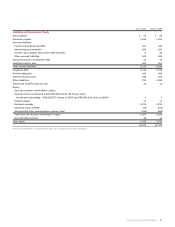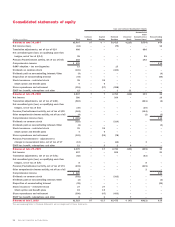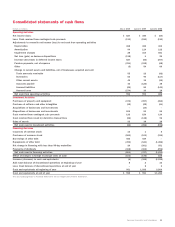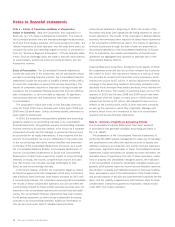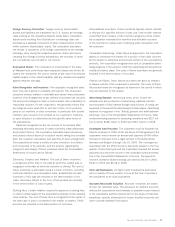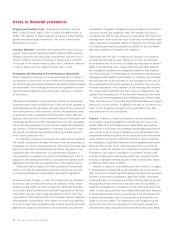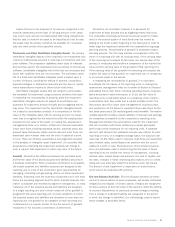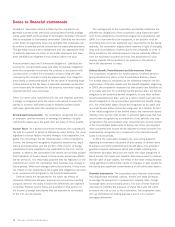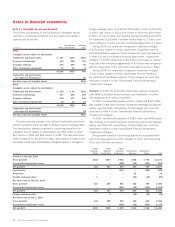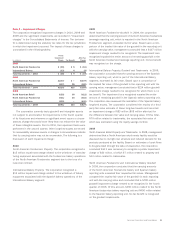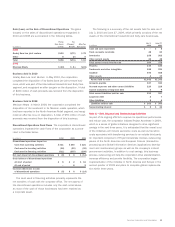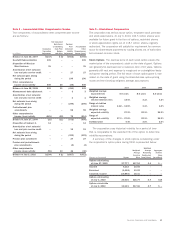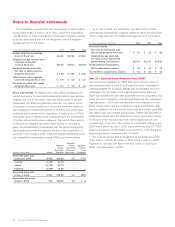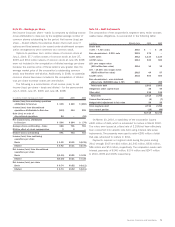Sara Lee 2010 Annual Report Download - page 63
Download and view the complete annual report
Please find page 63 of the 2010 Sara Lee annual report below. You can navigate through the pages in the report by either clicking on the pages listed below, or by using the keyword search tool below to find specific information within the annual report.
The corporation uses either hedge accounting or mark-to-market
accounting for its derivative instruments. Under hedge accounting,
the corporation formally documents its hedge relationships, including
identification of the hedging instruments and the hedged items, as
well as its risk management objectives and strategies for undertaking
the hedge transaction. This process includes linking derivatives that
are designated as hedges of specific assets, liabilities, firm commit-
ments or forecasted transactions. The corporation also formally
assesses, both at inception and at least quarterly thereafter, whether
the derivatives that are used in hedging transactions are highly
effective in offsetting changes in either the fair value or cash flows
of the hedged item. If it is determined that a derivative ceases to
be a highly effective hedge, or if the anticipated transaction is no
longer likely to occur, the corporation discontinues hedge account-
ing and any deferred gains or losses are recorded in the “Selling,
general and administrative expenses” line in the Consolidated
Statements of Income. Derivatives are recorded in the Consolidated
Balance Sheets at fair value in other assets and other liabilities.
For more information about accounting for derivatives see Note 15,
“Financial Instruments”.
Self-Insurance Reserves The corporation purchases third-party
insurance for workers’ compensation, automobile and product and
general liability claims that exceed a certain level. The corporation
is responsible for the payment of claims under these insured limits.
The undiscounted obligation associated with these claims is accrued
based on estimates obtained from consulting actuaries. Historical
loss development factors are utilized to project the future develop-
ment of incurred losses, and these amounts are adjusted based
upon actual claim experience and settlements. Accrued reserves,
excluding any amounts covered by insurance, were $187 million
as of July 3, 2010 and $201 million as of June 27, 2009.
Business Acquisitions In 2010, the corporation adopted new
accounting guidance related to business combinations, which requires
changes in the accounting and reporting of business acquisitions.
This guidance requires an acquirer to recognize and measure the
identifiable assets acquired, liabilities assumed, contractual contin-
gencies, contingent consideration and any noncontrolling interest
in an acquired business at fair value on the acquisition date. In
addition, it also requires expensing acquisition costs when incurred,
restructuring costs in periods subsequent to the acquisition date
and any adjustments to deferred tax asset valuation allowances
and acquired uncertain tax positions after the measurement period
to be reflected in income tax expense. The adoption of this guidance
has not impacted the consolidated financial statements.
Variable Interest Entities The corporation consolidates variable
interest entities (“VIEs”) of which it is the primary beneficiary. Legal
entities with which the corporation becomes involved are assessed to
determine whether such entities are VIEs and, if so, whether or not
the corporation is the primary beneficiary. In general, the corporation
determines whether it is the primary beneficiary of a VIE through a
qualitative analysis of risk, which identifies which variable interest
holder absorbs the majority of the financial risk or rewards and
variability of the VIE. In performing this analysis, we consider all
relevant facts and circumstances, including: the design and activities
of the VIE, terms of VIE contracts, identification of other variable
interest holders, our explicit arrangements and our implicit
variable interests.
The corporation enters into franchise agreements with
independent third party contractors (“Independent Operators”)
representing distribution rights to sell and distribute fresh bakery
products via direct-store-delivery to retail outlets in defined sales
territories. The corporation does not hold equity interests in any of
the Independent Operator entities. Independent Operators generally
finance the purchase of distribution rights through note agreements
with a financial institution, which, in the aggregate, are partially
guaranteed by Sara Lee. In addition, the corporation maintains
explicit and implicit commitments to maintain the function of routes
to ensure product delivery to customers. The corporation determined
that all Independent Operators are variable interest entities of which
it is the primary beneficiary, primarily as a result of Sara Lee’s debt
guarantee and other route maintenance obligations.
As a result of consolidating these Independent Operator
variable interest entities, the corporation reflected the following
in its balance sheets:
In millions 2010 2009
Inventories – finished goods $÷2 $÷1
Property – machinery and equipment 22 25
Total assets $24 $26
Current portion of long-term debt $12 $11
Long-term debt excluding current portion 58 66
Total liabilities $70 $77
Noncontrolling interests $23 $12
Lease obligations presented within long-term debt captions
on the balance sheet are secured by the vehicles subject to lease
and do not represent additional claims on the corporation’s general
assets. The corporation’s maximum exposure for loss associated
with the Independent Operator entities is limited to $52 million of
long-term debt of the Independent Operators as of July 3, 2010.
Sara Lee Corporation and Subsidiaries 61




